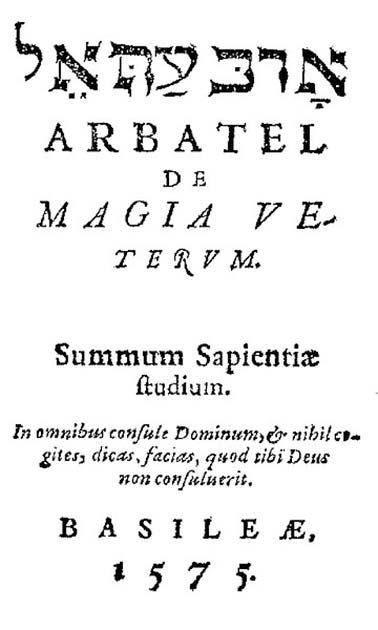A wizard’s spellbook is usually seen as a powerful item. Often the secrets contained within allow the magic user to cast potent spells or summon mighty creatures, but it doesn’t have to be like that.
Instead, some magic books are just about giving good advice. Take for example the Arbatel de Magia Veterum which stands as a beacon of light, offering seekers a unique blend of spirituality and ethical guidance.
This mysterious Latin grimoire is not your typical magical handbook. Instead, it beckons practitioners to a path of virtuous living and divine connection. The Arbatel de Magia Veterum is a book of white magic that preaches the use of magic for holistic purposes.
Let’s explore the essence of the Arbatel, what it contains, and what makes it so unique.
What Is The Arbatel?
The Arbatel De Magia Veterum (“On the Magic of the Ancients”), sometimes referred to as the Arbatel for short, is a mysterious Latin grimoire of ancient magic that was first published in Switzerland in 1575. While we know where and when it was written, no one knows who authored it or what the first word in the title actually means.
Even the term Arbatel is somewhat of a mystery. The British poet, scholar and mystic A. E Waite believed that the title comes from the Hebrew word ארבעתאל (“Arbotal”), which is the name of the angel from whom the author claimed to have learned some of his magic.
The German theologian Adolf Jacoby had a slightly different theory, believing the word was a reference to the Tetragrammaton, the Hebrew four-letter theonym for God. Others have simply theorized that the word is the author’s pseudonym.

While the book does make references to the use of magic, it is more of a spiritual guide that seeks to bridge the gap between the mundane and the divine, encouraging practitioners to lead virtuous lives and establish a profound connection with the divine realm. Its emphasis on morality and spirituality distinguishes it from the more ritualistic grimoires of its time.
What makes the grimoire really stand out compared to other similar texts is how straightforward its writings are and how positive its contents are. It’s also unusually honest, while many occult works claim to be from much earlier periods and from other regions, the Arbatel is honest about where and when it was written.
The Arbatel is structured into seven distinct books, each addressing different facets of magic and spirituality. These books collectively provide a framework for practitioners to cultivate a profound understanding of divine forces, virtue, and the harmonious coexistence of magic and morality.
While one normally expects a grimoire like this to inundate readers with spells, conjurations, and rituals, the Arbatel focuses on the philosophical and ethical foundation for magical practice. While it doesn’t delve into the arcane intricacies of incantations, it focuses on the significance of a pure heart and noble intentions in approaching magic.
The Seven Books
1. Isagoge: The Isagoge serves as the grimoire’s introduction. It mainly emphasizes the divine and moral nature of magic and tells amateur practitioners to approach magic with a pure heart and good intentions.
2. Theology of Magic: The next book explores the relationship between magic and divinity, discussing the role of God, angels, and spirits in magical practice.
3. Practical Magic: This is where things get more exciting. The third book provides guidance on the practical aspects of magic, including the use of magical words, symbols, and rituals. It also discusses the consecration of magical tools.
4. The Secrets of Celestial Magic: Here, the Arbatel explains the practice of celestial magic, involving working with angels and heavenly forces to achieve various goals.
5. The Secrets of Evocation of Spirits: This book offers instructions on summoning and communicating with spirits, detailing how to establish a connection with these entities.
6. The Secrets of Secrets: The sixth book is where the grimoire returns to some spiritual guidance. It covers a wide range of life’s aspects and discusses ethics, virtues, and provides guidance for living a harmonious and prosperous life.
7. Of the Magic of Ancients: The grimoire finishes with a bit of a history lesson and explores the magic practiced by ancient philosophers and how their wisdom can be applied in contemporary times.
The Teachings of the Arbatel
There are several themes that the Arbatel keeps returning to. It really focuses on the benefits of leading a virtuous and ethical life. Throughout history, magic has been associated with dark deeds and the devil but in the Arbatel a pure heart and noble intentions are the best way to harness magical powers.
Part of living a virtuous life is maintaining a deep connection with the divine. The author claims to have received his magic from angels and the grimoire emphasizes the role of God, angels, and spirits in magical practice, promoting a sense of reverence and respect for these entities.
- Practical Magic: The Summoning Spells of The Book of Abramelin
- The Book of Shadows: Is There a Secret Witches’ Spellbook?
A virtuous life is also self-less. While we usually think of magic being used for personal gain, the Arbatel recommends using it ethically. Practitioners are advised to use magic for virtuous and benevolent purposes, avoiding harmful or malicious intentions. The Arbatel tells how magic isn’t just about achieving personal desires but also about contributing to the greater good and the betterment of society.
These recommendations have made it a unique and enduring work in the realm of Western esotericism. Its focus on virtue, divine connection, and morality has resonated with those who believe that magic should be intertwined with ethical principles and a reverence for the divine.
The Arbatel was hugely influential for its time. The Arbatel’s emphasis on moral and ethical considerations in magic garnered appreciation from those who believe that magic should be intertwined with virtuous living. It served as a counterpoint to many grimoires of its time that often focused solely on ritualistic practices. It also had a significant impact on theology and is believed to be the first text of its kind to distinguish between human (anthroposophia) and divine (theosophia) knowledge.

Famous esotericists like John Dee and Johannes Bureus studied the book, claiming they used its teachings of divine magic to access new powers. Others like Ebenezer Sibly and Frederick Hockly incorporated parts of the grimoire into their own works. Historians and occultists alike have been fascinated by it, studying it for centuries.
But that’s not to say everyone was impressed. Despite the fact the book preaches the importance of God and the practice of holistic magic the Church wasn’t happy. The work was denounced as being “full of magical impiety” and censored. In 1617 the University of Marburg punished two professors who wanted to teach the grimoire and expelled a student found to be reading it.
Others just found issues with the book’s approach to magic. Some critics found fault with the Arbatel for its lack of detailed, step-by-step instructions for magical rituals. They considered it too philosophical and not practical enough for the aspiring magician.
Nonetheless, the Arbatel’s influence has endured through the centuries. It has been studied and referenced by occultists, magicians, and scholars interested in the intersection of magic, morality, and spirituality. Its unique blend of spirituality and ethics continues to make it a subject of fascination and discussion in the world of esotericism.
The Arbatel de Magia Veterum is a unique and enduring work in the realm of Western esotericism. While many ancient grimoires have focused on the selfish use of magic, the Arbatel is refreshingly different. Its lack of practical instructions may have infuriated some, but it has found a place among those who view magic as a path to spiritual growth and ethical living.
As the saying goes, never judge a book by its cover. Many of us may be tempted to discount the Arbatel due to its magical leanings but its teachings shouldn’t be discounted completely. The author’s teachings on putting others over oneself and using power to help the masses are just as relevant to non-believers as they are to believers.
Top Image: Unlike many spellbooks, the Arbatel de Magia Veterum had a lot of useful advice for living life well. Source: Hassanmim2021 / Adobe Stock.